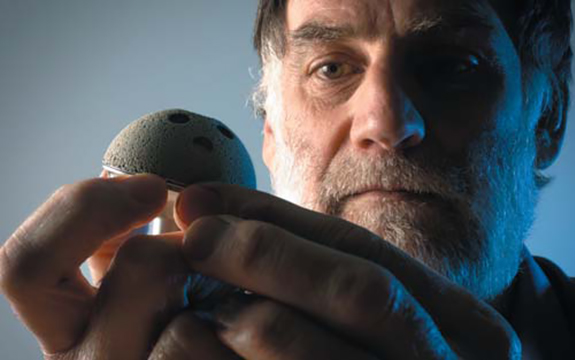Swinburne researcher recognised among science and innovation leaders

Distinguished Professor Berndt is a global leader in his field
In summary
- Swinburne’s Distinguished Professor Christopher Berndt has been awarded the $50,000 2021 Victoria Prize for Science and Innovation in the Physical Sciences
- The award is supported by the Victorian Government and delivered in partnership with veski
- The work helps build reliable surface engineering capabilities and technology to boost Victoria’s international access to markets, and therefore Australia’s position in advanced manufacturing
Swinburne’s Distinguished Professor Christopher Berndt has been awarded the $50,000 2021 Victoria Prize for Science and Innovation in the Physical Sciences for his innovative work focused on advancing surface engineering.
The award is supported by the Victorian Government and delivered in partnership with veski.
Distinguished Professor Berndt is a global leader in his field. He is the Director of the Surface Engineering for Advanced Materials (SEAM) training centre that is funded by the Australian Research Council.
Given the estimated cost of wear and corrosion is 4-5 per cent of gross domestic product in nations such as Australia, surface engineering produces important economic and environmental impacts. Coatings formed by a manufacturing process known as ‘thermal spray’ have industrial applications that experience demanding operating environments, for example in mining, power generating equipment, and heavy industry – the global thermal spray coating market exceeds US$10 billion.
‘Every artifact in the universe has a surface. If the properties of this surface can be designed and controlled, then society benefits. For example, a surface of an artificial hip or knee that integrates with tissue, a coating on a jet turbine that can better resist the high combustion temperatures, an engineered coating or surface modification on an industrial pipeline that resists corrosion: all examples where research is critical for an industrialized nation such as Australia,’ says Distinguished Professor Berndt.

Outcomes of Distinguished Professor Berndt’s achievements in building reliable surface engineering capabilities and technology boost Victoria’s international access to markets, and therefore Australia’s position in advanced manufacturing.
‘I started off as a cadet metallurgist, straight from high school, with BHP in Whyalla in South Australia. I had the opportunity to learn and experience the steel making industry from the practical hands-on viewpoint. I wanted to learn more – that is, why different metals behaved in strange ways. It all grew from there, and still continues, because I was, and still am, really inquisitive.’
‘I represent a team of engineers and scientists who have inspired me, and challenged me in many ways. This veski Prize for Science and Innovation acknowledges our hundreds of man-years of STEM investment, which I fully intend to leverage further into the future.’
-
Media Enquiries
Related articles
-

- Technology
- Science
- Engineering
Victorian students drive green energy transition through international hydrogen competition
Swinburne’s KIOSC, in collaboration with Horizon Educational and Gippsland Tech School, co-hosted the Hydrogen Grand Prix in Melbourne.Friday 26 July 2024 -

- Science
Skin, scales and fish tails: using collagen to turn fish guts into gold
New research from Swinburne could transform the sector by converting high value collagen proteins from seafood by-products into cosmetics, food, and pharmaceuticals.
Tuesday 02 July 2024 -

- Education
- Engineering
Transforming the lives of refugee engineers through the EPIC Program
Swinburne has been partnering with the Level Crossing Removal Project (LXRP) on the Engineering Pathway Industry Cadetship (EPIC) program, helping refugee engineers gain international qualifications for the Australian workforce through an 18-month paid cadetship program.
Thursday 20 June 2024 -

- Science
- Engineering
Submarines in the future could self-identify cracks and self-heal thanks to Swinburne researcher
Thanks to the work of Dr Nisa Salim from Swinburne University of Technology’s School of Engineering, future submarines could self-identify microcracks and self-heal using a new kind of carbon fibre reinforced polymer composites.
Monday 17 June 2024 -

- Science
Inaugural Swinburne-CSIRO Indigenous Research Fellow joins national water quality forecasting project
Swinburne University of Technology has appointed spatial ecologist Associate Professor Sally Waller as its inaugural Swinburne-CSIRO Indigenous Research Fellow...
Thursday 13 June 2024

